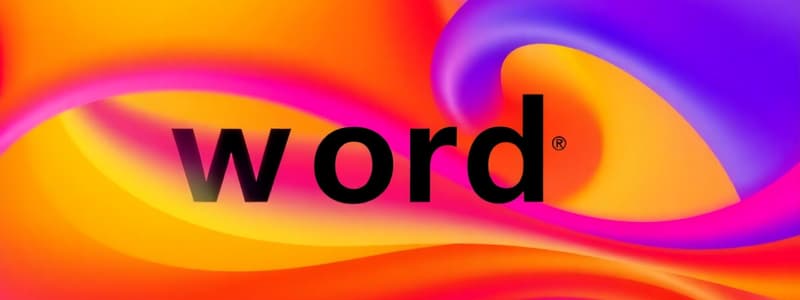Podcast
Questions and Answers
Which of the following is a key feature of word processors?
Which of the following is a key feature of word processors?
- Limited editing capabilities
- Spell check (correct)
- Manual formatting only
- Inability to save documents
Text editors and word processors have the same features and functionalities.
Text editors and word processors have the same features and functionalities.
False (B)
What is the blinking vertical line in a Word document called?
What is the blinking vertical line in a Word document called?
cursor
The Mail Merge feature allows you to send personalized invitations or documents to many people at ________.
The Mail Merge feature allows you to send personalized invitations or documents to many people at ________.
Match the word processor with its description:
Match the word processor with its description:
Which feature allows you to embed content from other programs into your document?
Which feature allows you to embed content from other programs into your document?
The 'Print' feature in a word processor ensures that what you see on the screen is what you get in the printed output.
The 'Print' feature in a word processor ensures that what you see on the screen is what you get in the printed output.
What is the temporary name given to a new blank document when Microsoft Word 2010 opens?
What is the temporary name given to a new blank document when Microsoft Word 2010 opens?
Which tab is used to create a new file in MS Word?
Which tab is used to create a new file in MS Word?
The Title Bar displays the application's name.
The Title Bar displays the application's name.
Which group on the Home tab includes commands for cut, copy, and paste?
Which group on the Home tab includes commands for cut, copy, and paste?
The ________ tab allows you to insert tables and illustrations into your document.
The ________ tab allows you to insert tables and illustrations into your document.
Which tab provides options for themes, page setup, and page background?
Which tab provides options for themes, page setup, and page background?
The Review tab is used for changing the document's layout.
The Review tab is used for changing the document's layout.
What is the main function of the Quick Access Toolbar?
What is the main function of the Quick Access Toolbar?
The zoom slider is located on the ________ bar.
The zoom slider is located on the ________ bar.
Match the view with it’s description
Match the view with it’s description
Which of the following functions is word wrap useful for?
Which of the following functions is word wrap useful for?
Flashcards
Word Processor
Word Processor
Application software used for creating, editing, saving, and printing documents.
Text Editor
Text Editor
Software for creating and editing plain, unformatted text.
Editing and Speed
Editing and Speed
Allows quick corrections, formatting, and easy document modification.
Formatting Features
Formatting Features
Signup and view all the flashcards
Storage Feature
Storage Feature
Signup and view all the flashcards
Spell Check
Spell Check
Signup and view all the flashcards
Mail Merge
Mail Merge
Signup and view all the flashcards
Object Linking and Embedding (OLE)
Object Linking and Embedding (OLE)
Signup and view all the flashcards
Working Area
Working Area
Signup and view all the flashcards
Title Bar
Title Bar
Signup and view all the flashcards
Quick Access Toolbar
Quick Access Toolbar
Signup and view all the flashcards
Ribbon
Ribbon
Signup and view all the flashcards
Word Wrap
Word Wrap
Signup and view all the flashcards
Insert Tab
Insert Tab
Signup and view all the flashcards
Outline View
Outline View
Signup and view all the flashcards
File Tab
File Tab
Signup and view all the flashcards
Scroll Bars
Scroll Bars
Signup and view all the flashcards
Status Bar
Status Bar
Signup and view all the flashcards
Study Notes
Introduction to Word Processor
- Application software used for creating, editing, saving, and printing documents.
- Unlike simple text editors such as Notepad, which are for plain text, it allows for extensive modifications.
- In the 21st century, writing is more accessible via the internet and impacts daily information.
Key Features of Word Processors
- Overcomes limitations of manual typewriters, offering ease and speed.
- Editing features includes functions to copy, move, delete, rename, apply paragraphs, page numbers, headers, and footers.
- Formatting features such as bold, italic, underline, font name, font color, and WordArt enhance text appearance.
- Documents can be stored and easily retrieved.
- Graphics capabilities include drawing, charts, and picture importing.
- Print feature provides a "what you see is what you get" output.
- Spell Check underlines incorrect spellings in red, offering auto-correct options upon right-clicking.
- Mail Merge simplifies sending mass invitations with personalized names and addresses.
- OLE (Object Linking and Embedding) allows embedding content from other programs, with automatically updating chart values.
- Popular options are MS Word, Open Office, Google Docs, Notepad, and LibreOffice Writer.
Intro to Microsoft Word 2010
- Part of the Microsoft Office suite.
- Used for creating, saving, opening, editing, and formatting documents.
- To start MS Word 2010, click the Start button then Microsoft Office, then Microsoft Word 2010.
- A blank document named "Document 1" appears when opened.
- The cursor, a blinking vertical line, indicates where the next character will appear.
- MS Word opens in two windows: the application window and the document window.
- The application window is used to communicate with MS Word.
- The document window is used for typing, writing, and formatting text.
The Components of MS Word Window
- MS Word 2010 has a user-friendly interface.
- Major interface components include: File Tab, Quick Access Toolbar, Title Bar, and Ribbon.
File Tab
- Replaced the Office Button in 2007.
- Allows creating, opening, saving, and printing files, among other functions.
Quick Access Toolbar
- Upper left corner, customizable with frequently used icons.
Title Bar
- Top of the window, displays the document's title, defaulting to "Document 1".
Ribbon
- Contains tabs like File, Home, Insert, Page Layout, References, Mailings, Review, and View.
- Each tab contains groups of related commands.
Ribon: Home Tab
- Common tab with command groups:
- Clipboard: Cut, copy, paste, and format painter.
- Font: Font type, size, style, color, etc.
- Paragraph: Alignment, indentation, bullets, numbering, etc.
- Styles: Predefined text styles.
- Editing: Find, replace, select.
Ribon: Insert Tab
- Used to insert elements:
- Pages
- Tables
- Illustrations
- Links
- Header & Footer
- Text
- Symbols
Ribon: Page Layout Tab
- Modifies document layout:
- Themes
- Page Setup
- Page Background
- Paragraph
- Arrange
Ribon: Reference Tab
- Manages table of contents, footnotes, citations & bibliography, captions, and index.
Ribon: Mailing Tab
- Used to create envelopes and labels, start mail merge etc.
Ribon: Review Tab
- Offers proofing (spell check, grammar), language, comments, and change tracking.
Ribbon: View Tab
- Controls document views, Show/Hide elements, Zoom, Window management, and Macros.
Clipboard
- Short-term storage for copied or cut content.
- Paste Options include copying hyperlinks and special files.
- The format painter copies formatting from one area to another.
Font Group
- Used to customize font size, style, color, subscripts, etc.
- Clear Formatting command reverts text to plain.
- Includes subscript and superscript options.
- Change the letter case to uppercase or lowercase.
Paragraph Group
- Features include bullets, numbering, multi-level lists, indent/decrease, paragraph settings, color, and alphabetical sorting.
- Has options to show/remove special characters and create right/left margins.
Styles Group
- Alters color styles and font size in the selected document.
- Heading options format titles.
Editing Group
- Used to find and replace text and add comments.
Working Area
- The main area for typing, editing, and formatting documents.
The Ruler Bar
- Located at the top and left sides of the screen.
- Vertical Rule: Vertical line indicating where the text begins.
- Horizontal Rule: Contains indents and margins used for page measurement.
Scroll Bars Vertical and Horizontal
- Used to navigate the current view.
- Located at the bottom and right of the window.
Use a Status Bar
- Located at the bottom edge of the window.
- Displays pages, words, and document information.
- Highlights proofing issues.
- Contains a zoom slider.
Document Views
- Print Layout: Shows how the document will appear when printed.
- Full Screen Reading: Displays the entire page.
- Web Layout: Shows the document as it would appear in a web browser.
- Outline: Shows document structure.
- Draft: Presents an unformatted version of the document.
Zoom Slider
- Located on the status bar.
- Allows quick document zoom.
Creating a Document
- Open MS Word.
- Click the File tab, then New.
- Select Blank document, then Create button.
- Alternatively, use Ctrl+End or the New Button in the Quick Access Toolbar.
Word Wrap vs. Enter Key
- Word Wrap: Automatically moves text to the subsequent line.
- Enter Key: Forces text to the next line or starts a new paragraph.
Word Wrap is good for
- Creating new lines of text
- To mark the end of a paragraph
- Leaving a blank line
Formatting Marks
- Indicate tabs, spaces, and markups such as:
- Dot = Space
- Paragraph Symbol = Paragraph
- Arrow Symbol = New Line
- Arrow With Lines Symbol = Position of tabs
Saving a Document
- Go to the File tab and click Save.
- Enter a name in the dialog box and click Save.
Saving a Document Using Passcode Protection
- Go to File tab, Save option, and open the dialogue box.
- Select Tools option, then General option.
- Enter a password to open and another to modify.
- Confirm the password after and the document is then protected.
- To change the password, enter a new code and update.
Studying That Suits You
Use AI to generate personalized quizzes and flashcards to suit your learning preferences.




